Prime Rib (Bone in)
Updated
Updated
I know how intimidating cooking a Prime Rib (bone in) can be—it’s a whole lot of meat! But I promise it’s easier than it looks. I cover my roast in a simple seasoning rub, then cook it low and slow in the oven and finish with a quick sear on the stove (for the perfect crust!). This tried-and-true method means you can better control the doneness of your meat for a juicy, tender roast every time. I never cook prime rib any other way, and neither should you!

Pin this now to find it later
Pin ItThis post may contain affiliate links. If you click on one and make a purchase, we may earn a small commission at no extra cost to you. We only recommend products we genuinely love.
A prime rib roast, also known as a standing rib roast, is one of my family’s all-time favorite holiday meals. It’s rich and meaty, easily feeds a crowd, and the leftovers make great sandwiches! But I know many people shy away from cooking it because they’re afraid to ruin such an expensive cut of meat. And I get it! So, to help ease those fears, I’ll walk you through the process step-by-step and give you all my tips and tricks for making the perfect roast on the first try.
But before you start, there are some non-negotiables. You’ll need a digital meat thermometer and a roasting pan with a grate. I also make a prime rib rub from simple seasonings like salt, pepper, garlic powder, fresh herbs, and brown sugar. After that, you only need a little patience and confidence in your cooking skills (even if they’re still developing!). Trust me; you’ve got this!
What’s in this Bone in Prime Rib Recipe?
Here’s what you’ll need to make the best prime rib roast recipe ever! Scroll down to the recipe card below for the exact measurements.
- Prime Rib Roast (Bone In): I recommend purchasing a roast where the ribs have been removed and reattached by a butcher. Your butcher tying the meat with the bones attached (known as trussing) helps to maintain its shape and texture when roasting. Then, once you reach your desired doneness, every slice will be more consistent. Also, a roast with more marbling (fat streaks) will create a juicier and more flavorful end product.
- Salted Butter: Covering the roast in salted butter helps form a delicious crust on the outside.
- Seasoning Rub: I make a homemade spice rub using sea salt, black pepper, fresh rosemary, fresh thyme, garlic powder, onion powder, smoked paprika, and dark brown sugar. The longer you let the rub sit on the meat, the more flavorful it becomes.
- Cooking Oil: I use a high-heat cooking oil (like canola or vegetable oil) to sear the meat after roasting. This is the reverse sear method and, in my opinion, is the BEST way to cook a perfect prime rib. I’ve covered this in more detail below.
Tips for Sourcing Prime Rib
When you order your roast from the butcher at a specialty shop or your local grocer, you can order by number of ribs or pounds. I order by pound and plan to feed a family of 5 on this special day, so I ask for around 5 pounds of meat. You have to be a bit flexible here, but a great butcher can get you pretty close to your exact needs. My 5.10-pound roast came with 2 ribs (removed and then reattached by the butcher for ease of carving— you’ll likely need to ask your butcher to do this for you) and was perfect for our holiday feast.
Traditionally, cutting off the ribs and tying them back on means you get “the best of both worlds”: ease of carving while still achieving the extra flavor from the bones. Personally, I don’t think the bones add much extra flavor, but they do help with the evenness of cooking, and my husband loves them.
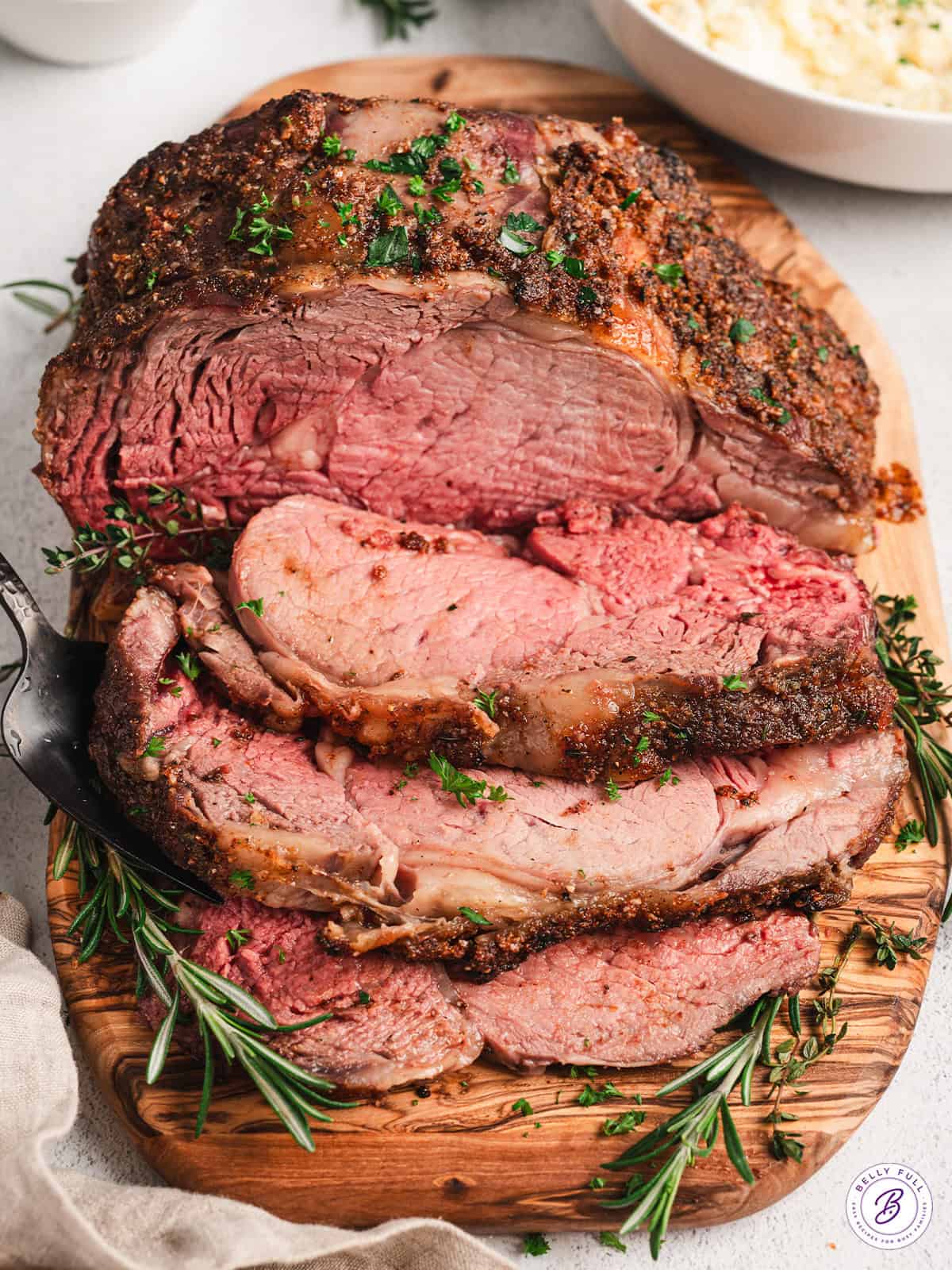
What’s the Best Way to Cook Prime Rib?
In my opinion, the reverse sear method is the best way to cook a thick cut of meat like a prime roast. This method involves cooking the meat at a low temperature in the oven and then ending with a quick, high-heat sear on the stovetop.
When you’ve roasted your prime rib in the oven on low for multiple hours (in our case, 5 ½ to 6 ½ hours), it has had plenty of time for the surface to dry, which helps with the Maillard reaction and makes the perfect sear more possible! The Maillard reaction is a chemical reaction that occurs when amino acids and sugars in food (in this case, your roast) are exposed to high heat, creating a caramelized crust. This adds an extra layer of flavor and texture to your meat while the inside keeps its perfect temperature.
Prime Rib vs. Rib-Eye Steak
Essentially, a rib eye steak is a single serving cut from a prime rib roast before it’s cooked. Both cuts come from the same primal section of beef and share similar marbling and tenderness. However, the roast is typically bone-in (but can be purchased boneless), while the steak is often boneless (but can also be found bone-in). You’ll also cook them differently—prime rib is usually roasted, while a rib-eye steak can be grilled, pan-seared, or broiled. They’re both super flavorful and tender, but the whole roast is definitely a showstopper at a dinner party!
Tips for Success
- Roast the meat fat side up. When roasting prime rib in the oven, I always place my roast fat side up. This positioning allows for a barding effect, where the melting fat bastes the meat, keeping it moist and flavorful. Plus, the rib bones act as a secondary roasting rack!
- Let the meat come to room temperature. You don’t want to put a cold piece of meat into a hot oven. I let my roast sit at room temperature for about 30 minutes before popping it into the oven. This ensures better heat distribution and helps the meat cook more evenly. No overcooked crust or undercooked middle here!
- Pat the roast dry. Use paper towels to dry the meat before adding the butter and seasoning rub. This allows everything to stick better and will also help with the Maillard reaction (browning).
- Massage the seasonings into the meat. Don’t just sprinkle the seasonings on top—I use my hands to really massage them into the meat. This helps create a flavorful crust that will enhance the flavor of the entire roast.
- Marinate overnight, if possible. I recommend letting your meat marinate for at least an hour, but overnight (up to 24 hours) is ideal. The salt from the seasoning rub and butter will draw out the juices from the meat, which will reabsorb and help tenderize the roast while adding flavor.
- Elevate your roast. When making this recipe for prime rib, I always use a roasting vessel with a grate or rack to elevate the meat. This allows for heat circulation, creating a more crispy and evenly cooked exterior.
- Use a meat thermometer. I urge you to invest in a good meat thermometer if you haven’t already! This is the best way to ensure your bone in prime rib is cooked to perfection. I’ve shared the exact temperature ranges I use for rare, medium rare, medium, and well done in the recipe card below.
- Don’t cover your roast! We want the air to circulate around the roast to get the best crust possible, even before reverse-searing it.
- Save the bones and drippings. Don’t toss out those rib bones! They’re perfect for making a rich and flavorful beef stock or soup. I also highly recommend saving the drippings from your roast to make a decadent au jus sauce or gravy.
Serving Suggestions
This impressive roast needs a spot on your holiday table this year. I usually serve it with all the traditional fixings for my family, like mashed potatoes or my easy crockpot mashed potatoes, roasted green beans, homemade creamed corn, and gravy made from the drippings. A side of horseradish sauce is also a must!
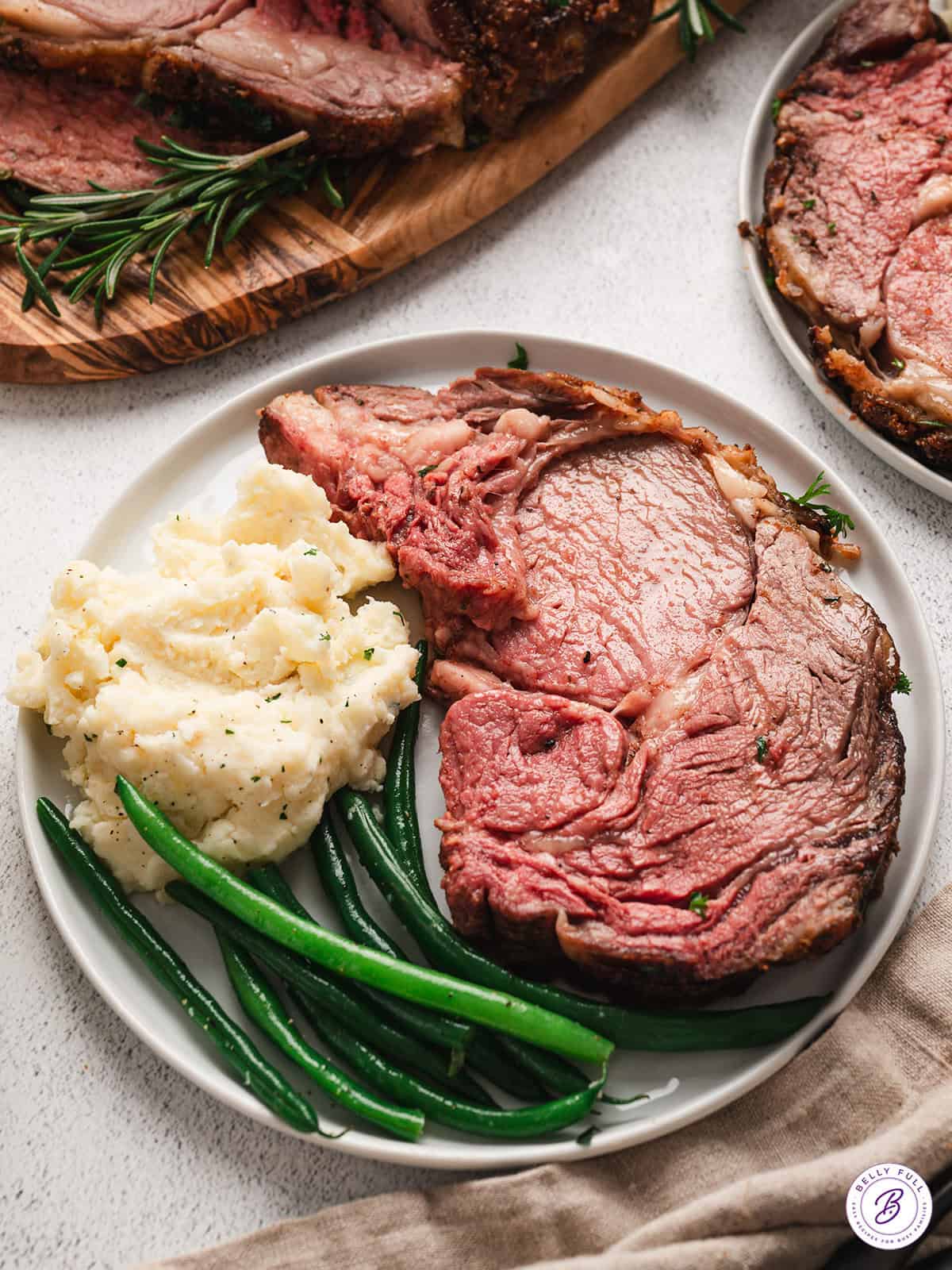
Proper Storage
- Fridge. Wrap any leftovers from this easy prime rib recipe in plastic or store them in an airtight container. The leftover meat might dry out a little as it’s stored, but it can last up to 3-4 days in the fridge.
- Freezer. I’d place the leftovers in a freezer-safe container and freeze for up to 3 months. Let the meat thaw in the fridge overnight before reheating.
- Reheat. You have to be careful when reheating leftovers, or this beef can easily overcook! I recommend heating up your beef in a 325F oven on a roasting vessel with a roasting grate. Add a little beef stock and cover with foil. The leftovers should reach 160F internally, as per the USDA, which means your meat will lose its pinkness.
I hope you love this delicious and easy recipe – be sure to give it a review below! Also don’t forget to follow Belly Full on TikTok, Facebook, Instagram, Pinterest, and YouTube!
Prime Rib (Bone in)
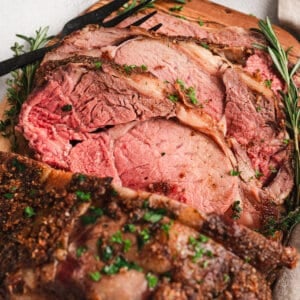
Ingredients
- 1 prime rib roast (5 pound), , ribs removed and reattached by butcher
- 3 tablespoons salted butter, , softened to room temperature
- 2 tablespoons sea salt
- 2 teaspoons black pepper
- 2 tablespoons fresh rosemary, , removed from stems and minced
- 1 tablespoon fresh thyme, , removed from stems and minced
- 1 tablespoon garlic powder
- 1 teaspoon onion powder
- 1/2 tablespoon smoked paprika
- 3 tablespoons dark brown sugar
- 2 tablespoons cooking oil
Instructions
- Pat your roast dry with clean paper towels. Then, smear the softened 3 tablespoons of salted butter all over the roast.
- Combine 2 tablespoons sea salt, 2 teaspoons black pepper, 2 tablespoons fresh rosemary, 1 tablespoon fresh thyme, 1 tablespoon garlic powder, 1 teaspoon onion powder, 1/2 tablespoon smoked paprika, and 3 tablespoons dark brown sugar in a mixing bowl. Whisk to combine.
- Using a spoon, sprinkle the seasoning rub, one side at a time, on the meat and rub in with your hands. (I like to evenly pile a little extra on top at the end!)
- Let your roast sit with this rub on it for a minimum of 30 minutes, or up to 24 hours, in the fridge, uncovered.
- Bring your meat back to room temperature before cooking by letting it sit out for 30 minutes (not longer than 1 hour) at room temperature. Preheat your oven to the lowest temperature it can be set to. My oven goes to 170F. Transfer your rubbed prime rib to your roasting vessel with a roasting grate on the bottom.
- Roast your beef *rib side down* in the oven uncovered for 5 ½ to 6 ½ hours, depending on your preferred level of doneness. (Anything beyond medium when it comes to prime rib is widely considered sacrilegious, but you do you!)
- This part is important: Based on your personal preference, remove your roast from the oven when your digital meat thermometer reads the following:– Rare: 120°F, with a red interior that may fade to pink at the edges (As it rests, it will reach 125°F, a perfect rare steak)– Medium rare: 130°F, with a pink color and a deeper, nearly red center (As it rests, it will reach 135°F, a perfect medium rare steak)– Medium: 135°F, with a mauve color, pink center, and a uniformly colored interior (As it rests, it will reach 140°F, a perfect medium steak)– Well done: 145°F or higher, with a brown color and no pink
- Remove roast from the oven and let it rest for 20 minutes before reverse searing.
- To reverse sear the prime rib, add 2 tablespoons of high heat cooking oil to a large cast iron skillet on medium high heat. Give the oil a swirl, if it swirls around your pan with ease, it’s ready. If it’s slow-moving, it’s not hot enough yet. Add the roast to the skillet and let it sear on each side for 2 minutes to create the textured crust that everyone loves. Do not sear for longer than 8 minutes total on all sides if you want to maintain the level of doneness you have already achieved during the cooking and resting process.
- Once you have seared all sides of the meat (no need to attempt to sear the ribs still tied on the bottom), you can carve and serve it immediately.
- Alternatively, you can preheat your oven to 500F while you’re waiting for your meat to rest for 20-30 minutes and your guests are enjoying appetizers or cocktails. Just before you’re ready to serve it, pop the roast into the 500F oven for 15 minutes. Remove from the oven, carve, and serve immediately!
Notes
Nutrition
Nutritional information given is an automatic calculation and can vary based on the exact products you use and any changes you make to the recipe. If these numbers are very important to you, I would recommend calculating them yourself.
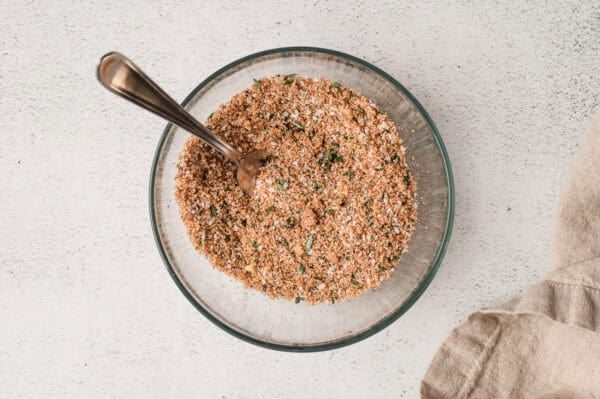
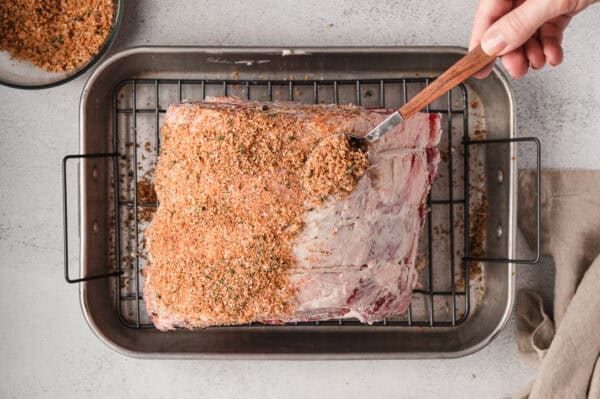
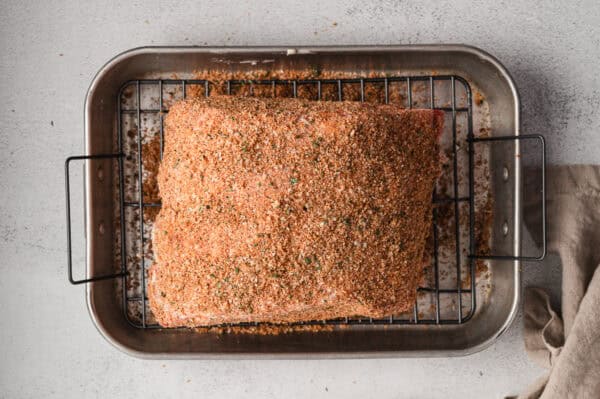
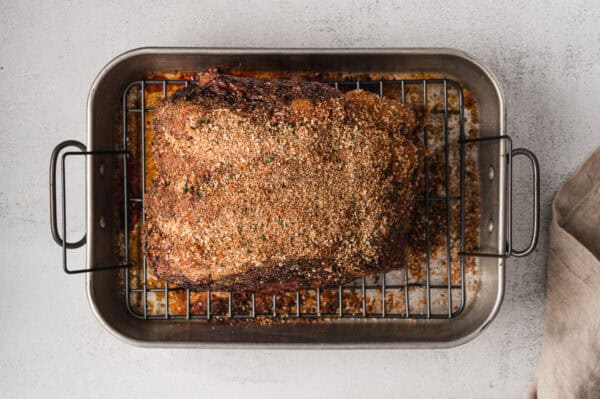
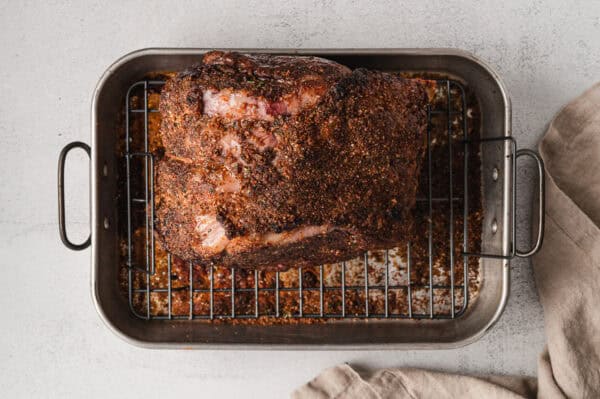
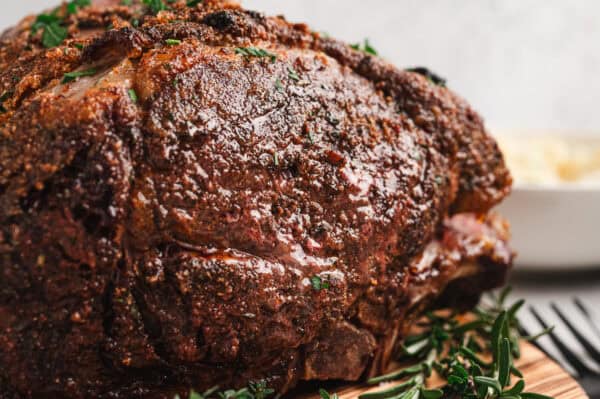
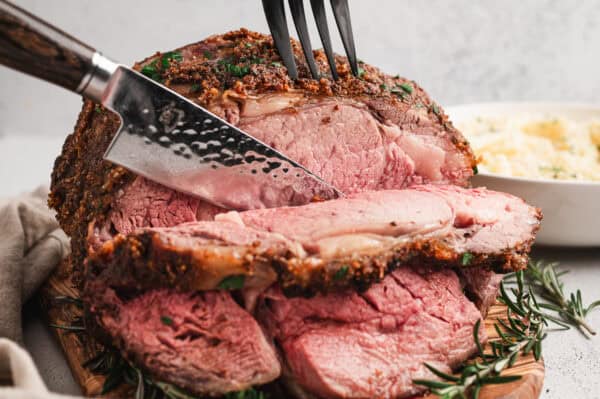
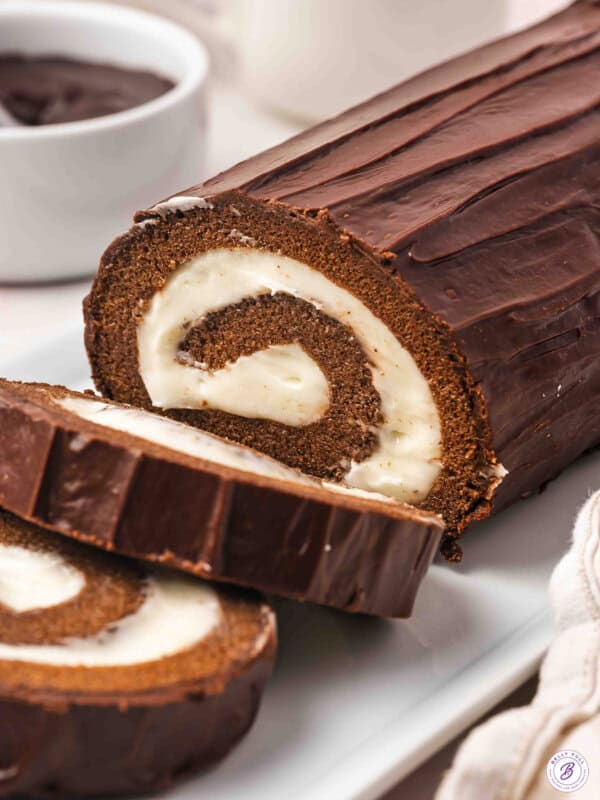
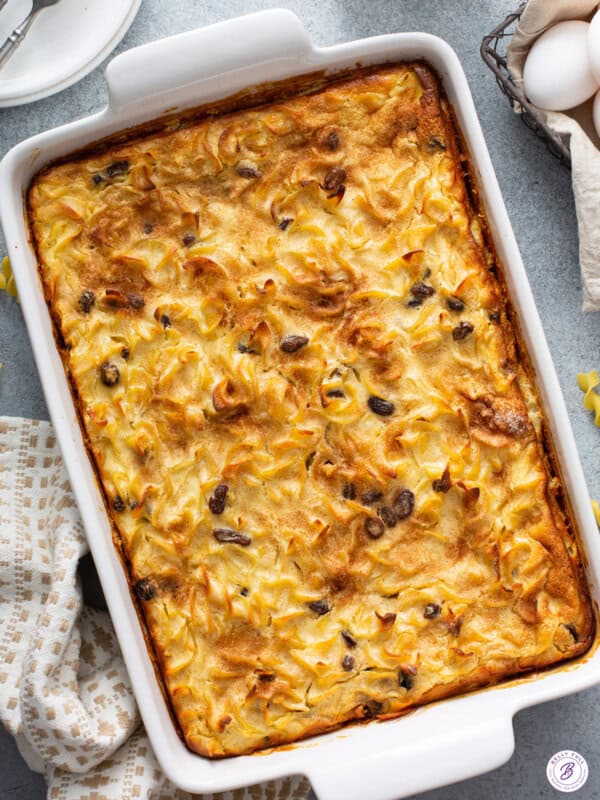
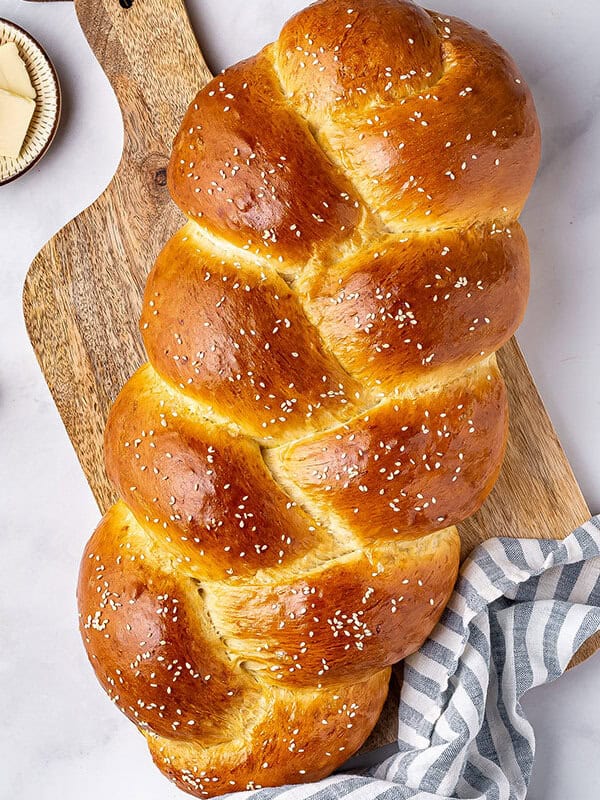
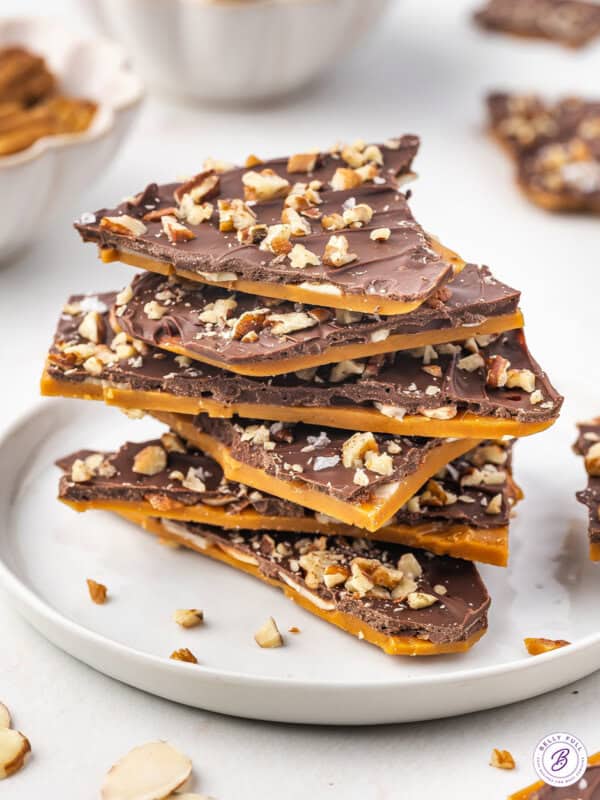






I haven’t made this yet. I will be making it on Christmas Day and it sounds delicious! I serve this with a broccoli casserole I have been making for years and Yorkshire pudding when I can convince a butcher to save me some beef fat when he is trimming the beef. Hard to find in modern grocery stores these days.
I plan to use your reverse sear recipe this year for our prime rib. I will be preparing/serving a 12 lbs bone-in cut of prime rib. Do I need to increase the oven sear time from 15 minutes since this is larger than the 5 lbs example cited? I assume peanut oil is a suitable cooking oil or do you recommend sticking with canola? Thank you for your quick response.
Hi Art! You should really be cooking it based on the doneness level, so check the temp every 30 minutes or so after 6 hours. It will definitely take longer to cook than a 5 pound roast as written, obviously, so give yourself enough time. I would not recommend peanut oil.
You missed the point of my question, My question was with the “sear time” I understand that a 12 lbs roast will take longer to cook, but I wanted to know if the sear time should be increased also, since it is 12 lbs, vs 5 lbs? Thanks
The sear time would be the same. You just want a good crust on it, it’s not doing anything to the internal temperature of the meat at this point. It’s about the surface area of the meat, so make sure you have a skillet large enough to maximize the surface area contact. Flip it and don’t touch it or move it to get a good crusty sear and browning.
You talk about searing #10 in the directions than #11 states alternately going in the oven, do you do both or one or the other
Hi Tina! Alternatively means OR, so if you don’t want to sear on the stovetop, you could do the oven directions instead.
I used this recipe today making my prime rib. AMAZING! The cook times and instructions are spot on. Only change that I made was in seasoning. I modified that to my taste. The crust is so good! I printed the recipe so I had it quickly next time. Thanks for the great recipe!
I have been so nervous to try to make this . Thank you for the great instructions!
Wow. Just outstanding. The rub is what makes it. Thanks for the great instruction.